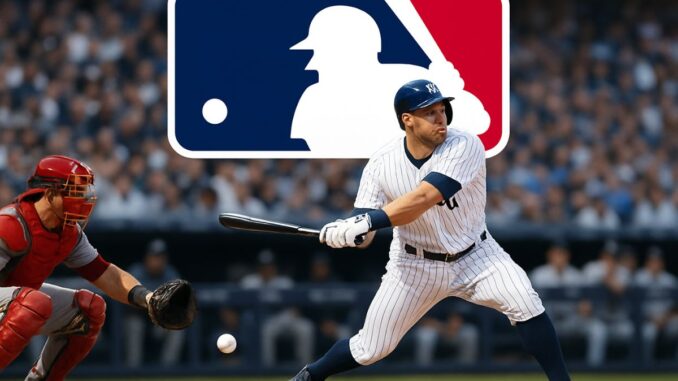
Every spring, Major League Baseball kicks off a long and exciting season, punctuated by clashes between American and Canadian franchises. For fans and players alike, it’s a marathon of sport and strategy, stretching out over several months until the eagerly-awaited World Series. Behind the spectacle, there is a whole complex organisation that structures the calendar and the competitions.
The MLB season is not just a series of matches: it is designed to separate the best teams in a balanced framework, where every performance counts. Between divisions, leagues, series and finals, the system is both rigorous and exciting.
The MLB regular season calendar
The MLB regular season generally begins in late March or early April, with Opening Day symbolically marking the start of the competition. Each team plays 162 games over nearly six months, an impressive number that testifies to the stamina demanded of the players. The packed schedule of matches means that the squad has to be managed to the last detail, with very few days off.
These matches are organised so that opponents from the same division as well as those from other leagues play against each other. The MLB is divided into two leagues: the American League and the National League, each with three divisions (East, Central and West). Interleague series, in which a team from the National League plays a team from the American League, have been included for several years.
The All-Star Game, scheduled for mid-season in July, rounds off the first part of the calendar. This is an exhibition match between the best players in each league, selected by fans, coaches and journalists.
How divisions work in baseball
The MLB has 30 franchises divided geographically and historically into two leagues. These leagues are themselves divided into three divisions: East, Central and West. Each division comprises five teams, which play each other several times during the season. Belonging to a division structures the confrontations and forges the great rivalries of North American baseball.
For example, the Yankees regularly play the Red Sox in the American League East, while the Dodgers and Giants face off in the National League West. These split duels establish division-specific rankings, which are crucial for qualification for the playoffs.
At the end of the regular season, the top teams in each division automatically qualify for the play-offs. This system fosters competitiveness throughout the year, with key match-ups right up to the final days of the calendar.
MLB playoff format
The MLB playoffs generally begin in early October and run until the end of the month, or even early November for the World Series. In all, 12 teams qualify: the six division champions and six wild card teams. The MLB play-off system rewards consistency and performance, while leaving room for surprises thanks to the wild cards.
The first stage is the Wild Card Round, which pits the drafted teams against each other in best-of-three series. The winners then join the division champions in the Division Series (best of five games), followed by the Championship Series (best of seven games).
Finally, the two league winners – one from the American League, one from the National League – meet in the World Series, the grand final. The World Series is played over a maximum of seven games to decide the MLB champion.
The place of baseball teams in the competition
Each franchise has a strong identity, often rooted in the sporting and cultural history of its region. Some baseball teams, such as the New York Yankees, the St. Louis Cardinals and the Los Angeles Dodgers, have a prestigious track record. The role of baseball teams goes beyond mere sporting performance; they unite a community of passionate fans.
The internal workings of each club are based on a highly structured staff, with data analysts, physical trainers and tactical managers. Recruitment takes place via the minor leagues or through international player transfers. The MLB is a magnet for top talent from Japan, Cuba and the Dominican Republic.
The system for rotating pitchers and the strategy for using outfielders varies from team to team. These choices are crucial in managing the 162 games that make up the regular season.
Key dates not to be missed
The MLB season is punctuated by a series of important dates that punctuate the sporting year. These highlights allow fans and players alike to plan ahead and anticipate major events. Certain key moments change the course of a baseball season, both strategically and emotionally.
Here are a few moments to remember:
- Opening Day: official start of the season (late March/early April)
- All-Star Game: mid-season all-star game (July)
- Trade Deadline: deadline for transfers (31 July)
- Start of the play-offs: late September/early October
- World Series: last week of October
There are also traditional events such as the 4 July matches and historic confrontations. The calendar is therefore structured around key annual landmarks.
MLB: between tradition and innovation
Major League Baseball retains a strong tradition in its presentation, rules and atmosphere, but it also knows how to evolve with the times. Recent years have seen the introduction of measures to shorten game times, such as the pitch clock. MLB is adapting its rules to make the spectator experience more dynamic, without betraying its essence.
From a technological point of view, the league is relying on data analysis to assess performance. Advanced statistics such as WAR and xERA are now at the heart of sporting decisions. In addition, the broadcasting of games on digital platforms has enabled the MLB to attract a younger, more international audience.
Teams are incorporating these innovations while retaining the ritual aspect that is the beauty of baseball. The combination of history, strategy and adaptation is one of the league’s major strengths.

